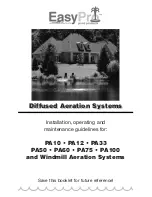
JSC
“Forteza”
“Forteza
Tribo
‐
M”
operation
manual
8
3.
APPLICATION
To
ensure
the
required
detectability
(unauthorized
actions
detection),
high
noise
immunity
(actually
an
utter
absence
of
false
responses)
and
specified
sabotage
resistance
THE
FOLLOWING
SHOULD
BE
PROVIDED:
•
proper
fence
mounting
(flexible
fences
should
be
stretched
uniformly
with
specified
tension
force);
•
combination
of
different
‐
type
fences
and
of
tribocable
laying
and
fastening
schemes;
•
fence
uniformity,
i.e.
the
fence
should
be
made
of
the
same
material
as
different
‐
material
sections
generate
signals
of
different
strength
when
subjected
to
an
unauthorized
action;
•
tribocable
proper
installation
and
tightness;
•
SPU
sensitivity
setting
with
specified
detectability.
3.1.
Versions
of
Fence
Equipping
Possible
are
the
following
versions
of
the
guard
alarm
installation:
‐
flexible
fence
made
of
reinforced
barbed
tape
,
wire
netting,
wire
netting
“Rabitsa”,
barbed
wire,
etc.
(Fig.1);
‐
rigid
(continuous)
fence
made
of
metal
elements
(forged
and
welded
gratings,
solid
metal
plates,
corrugated
plates,
etc.),
concrete,
bricks,
wood,
etc.
(Fig.2);
‐
gates,
wickets,
etc.
(Fig.3).
3.1.1.
Flexible
Fence
(Fig
.
1)
Flexible
fence
is
actually
a
fence
made
of
metal
wire
netting
according,
barbed
wire,
wire
of
rust
‐
resistant
steel,
bimetallic
wire,
reinforced
barbed
tape,
etc.
The
sensor
is
mounted
directly
on
the
fence
flexible
elements.
The
supports
enabling
a
violator
to
get
over
the
fence
without
touching
its
flexible
elements
being
available,
the
sensor
is
mounted
on
the
supports
as
well.
The
“Alarm”
signal
is
generated
on
the
flexible
fence
under
local
deformation
of
the
fence
and
the
sensor
fastened
to
it
in
case
of
unauthorized
penetration
by
getting
over
the
fence,
no
facilities
being
used,
and
as
a
result
of
damage
to
the
fence,
the
sensor,
and
its
fasteners.
To
obtain
the
required
noise
immunity,
be
sure
to
limit
the
flexible
fence
mobility
under
wind
as
much
as
possible.
3.1.2.
Wire
Netting
Fence
(Fig.
1
а
)
The
wire
‐
netting
fence
should
meet
the
following
requirements:
make
sure
the
netting
is
stretched
uniformly
between
the
fence
supports
in
a
horizontal
plane
with
a
force
of
100
kg,
minimum.
3.1.3.
“Rabitsa”
Wire‐Netting Fence
(Figs
1b
and
1c)
The
“Rabitsa”
wire
‐
netting
fence
should
meet
the
following
requirements:
•
make
sure
the
netting
is
stretched
uniformly
between
the
fence
supports
in
a
horizontal
plane
and
fastened
to
the
upper
and
lower
wire
ropes
(Fig.
1b);
•
a
frame
made
of
angle
sections
being
used,
make
sure
the
netting
is
stretched
uniformly
and
fastened
to
the
all
sides
of
the
frame.
In
addition
be
sure
to
lay
the
sensor
along
the
upper
angle
section
of
the
frame
and
the
fence
supports
(Fig.
1c).
Summary of Contents for TRIBO-M
Page 1: ...TRIBOELECTRIC GUARD ALARM FOR PERIMETER AREAS FORTEZA TRIBO M Operation manual 2010 ...
Page 22: ...JSC Forteza Forteza Tribo M operation manual 22 ...
Page 23: ...JSC Forteza Forteza Tribo M operation manual 23 ...
Page 24: ...JSC Forteza Forteza Tribo M operation manual 24 ...
Page 25: ...JSC Forteza Forteza Tribo M operation manual 25 ...
Page 26: ...JSC Forteza Forteza Tribo M operation manual 26 ...
Page 27: ...JSC Forteza Forteza Tribo M operation manual 27 ...
Page 28: ...JSC Forteza Forteza Tribo M operation manual 28 ...
Page 29: ...JSC Forteza Forteza Tribo M operation manual 29 ...
Page 30: ...JSC Forteza Forteza Tribo M operation manual 30 ...
Page 31: ...JSC Forteza Forteza Tribo M operation manual 31 ...
Page 32: ...JSC Forteza Forteza Tribo M operation manual 32 ...
Page 33: ...JSC Forteza Forteza Tribo M operation manual 33 ...









































